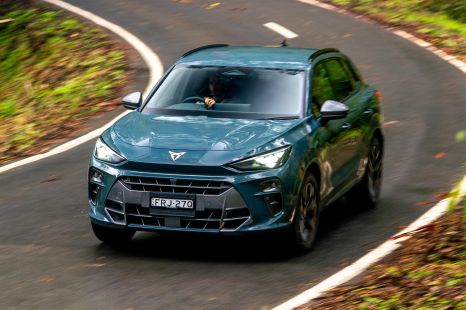

Matt Campbell
2026 Cupra Terramar review
1 Hour Ago
Guest User
My dashboardThe updated Nissan Navara ST-X is now what the D23 should've been all along. But for my money the Isuzu D-Max X-Terrain just edges it.

Senior Contributor
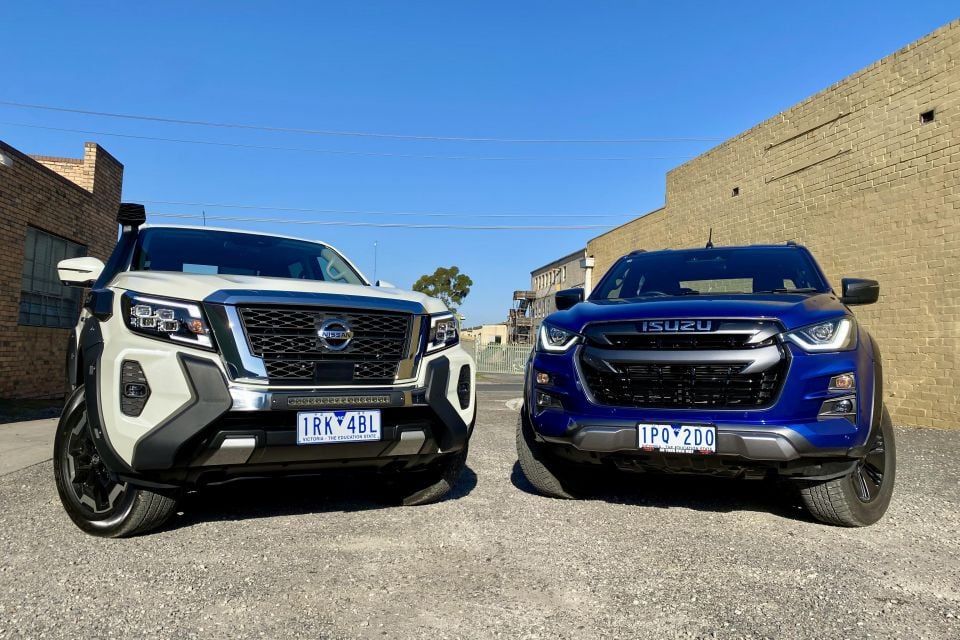

Senior Contributor
The Nissan Navara has just received a really solid set of updates designed to make it more competitive with newer ute offerings. Offerings like the Isuzu D-Max.
This pair of workhorses are both trying to eat away at the market dominance of the Toyota HiLux and Ford Ranger, and make good cases.
The updated Navara looks tougher than ever, picks up a stronger rear axle, bigger rear brakes, a more voluminous tub, new steering wheel and instrument designs, as well as a suite of long-overdue new active safety features.
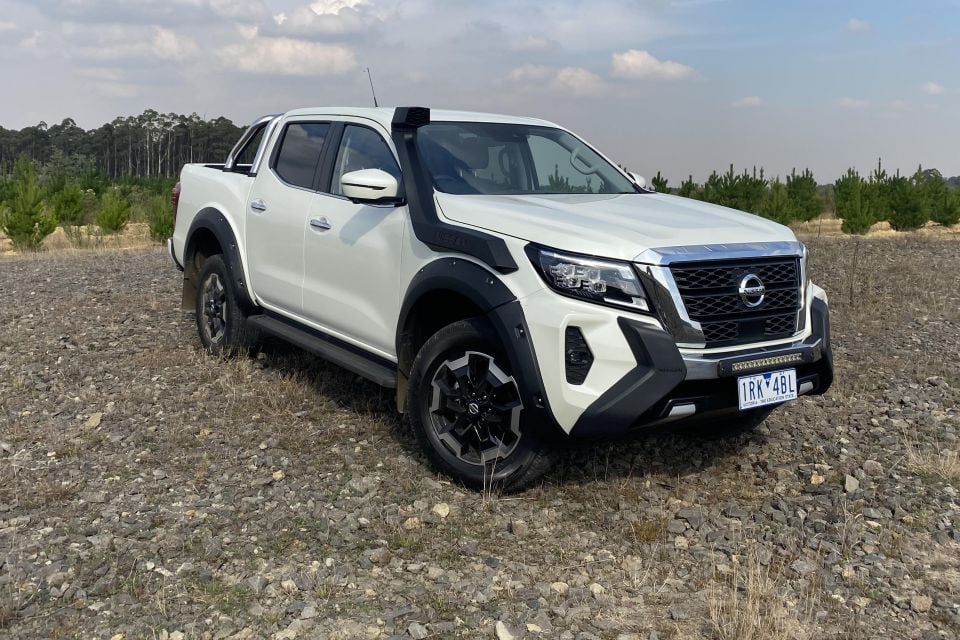
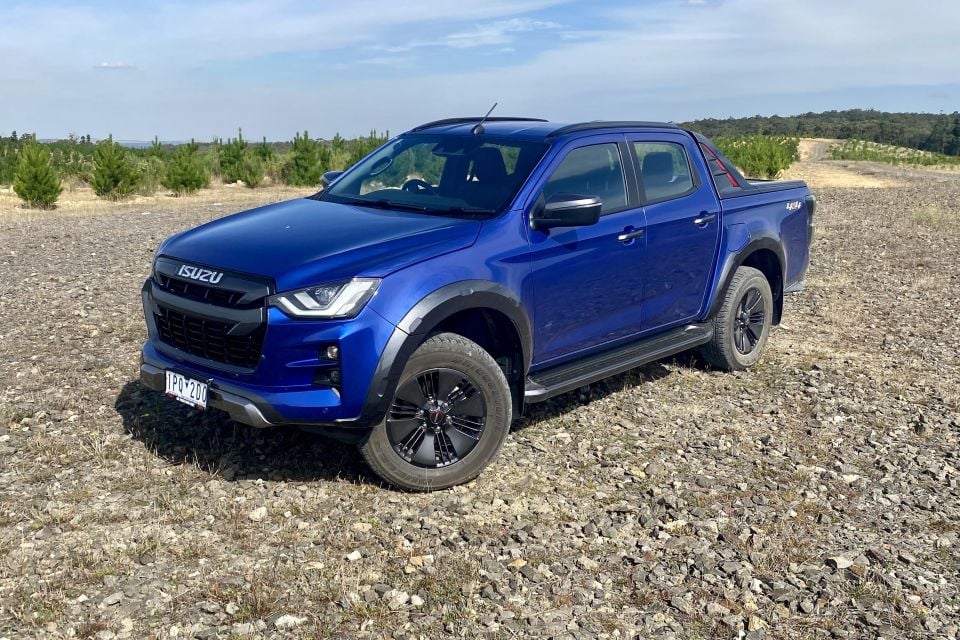
The D-Max hit the market in the middle of 2020 and is the subject of such high demand that stock shortages have become a headache for its maker. It’s as utilitarian as ever, but infinitely more refined and high-tech than its predecessor.
The grades we’re testing here are the top-of-the-range Isuzu D-Max X-Terrain versus the second-from-top Nissan Navara ST-X. We’re driving the ST-X in lieu of the new PRO-4X variant which was not yet available for testing.
The respective MSRP list prices are $62,900 before on-road costs for the Isuzu and $58,270 plus on-roads for the Nissan.
But these numbers are not as important as the drive-away pricing, which at the time of writing according to each brand’s website was $59,990 on the road for the Isuzu and $58,270 for the Nissan, for private buyers.
You’ll drive both out of the showroom for under $60k if you avoid options and accessories.



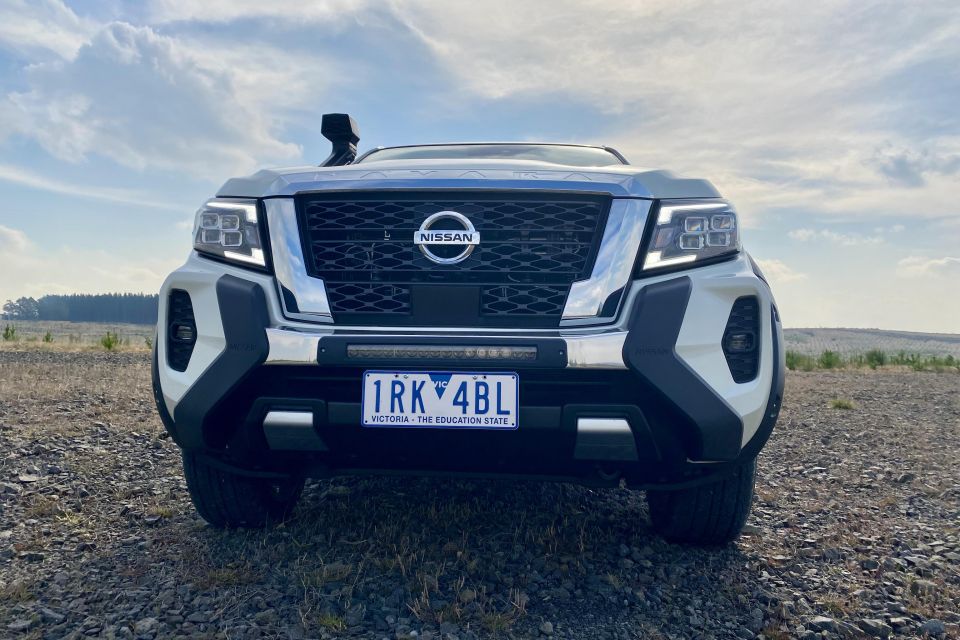
Common to both are 18-inch alloy wheels on highway tyres, LED headlights, proximity key access with push-button start, dual-zone climate control, satellite-navigation, Apple CarPlay and Android Auto, a digital speedo, automatic wipers, and a tub-liner.
The Isuzu comes standard with leather seats and driver-side electric adjustment, unlike the Nissan. However, for $1500 extra you can switch out the Nissan’s manual cloth seats for our test car’s leather trim with electric driver-side adjustment and heating for both front occupants.
The Isuzu gets unique features such as wireless Apple CarPlay, a ramped-up eight-speaker sound system (the Nissan has six speakers), a rolling-style hard tonneau cover, a sailplane-style tub body kit, remote engine start function, and roof rails.
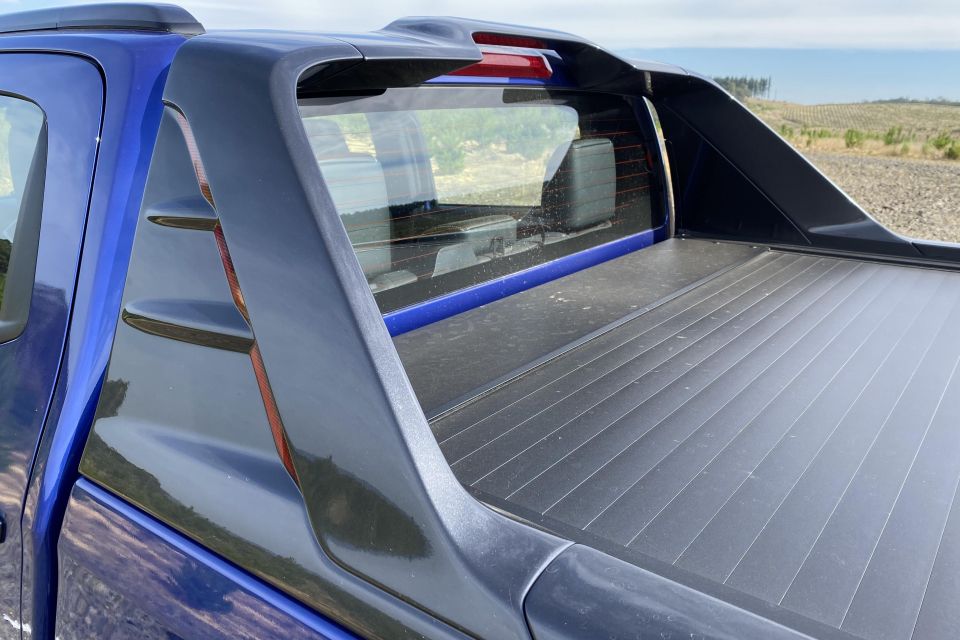
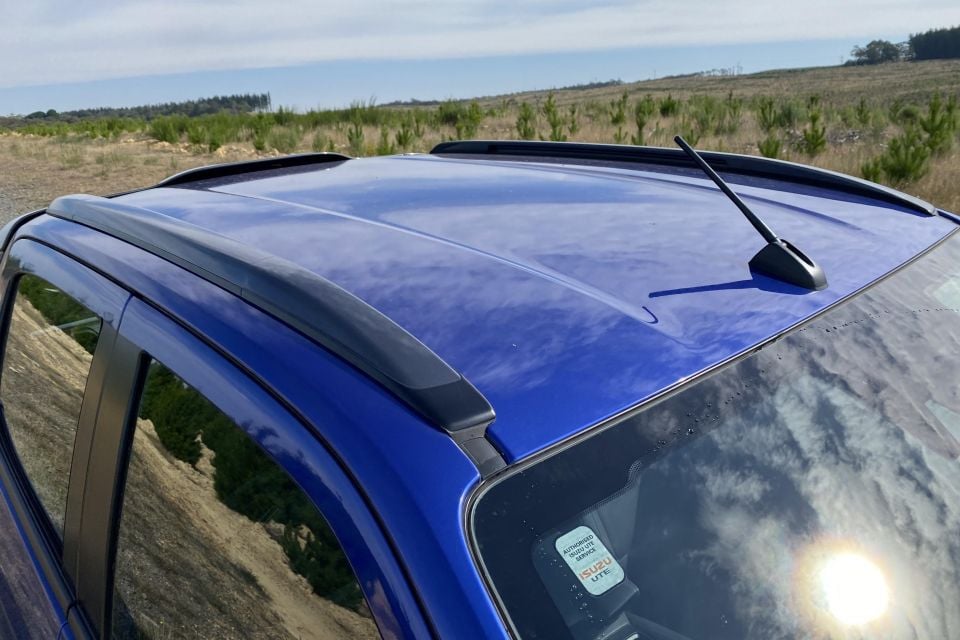
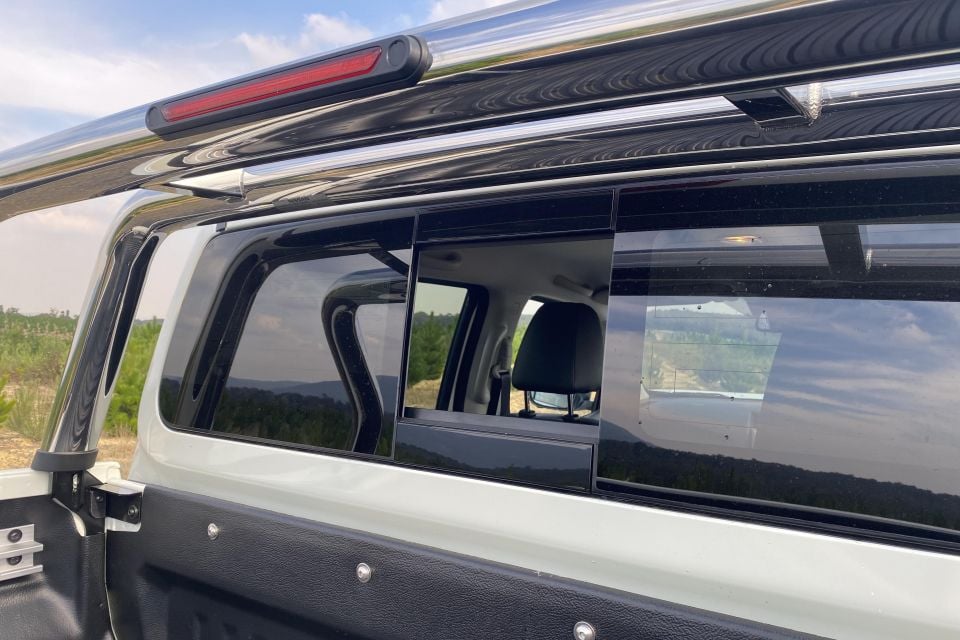
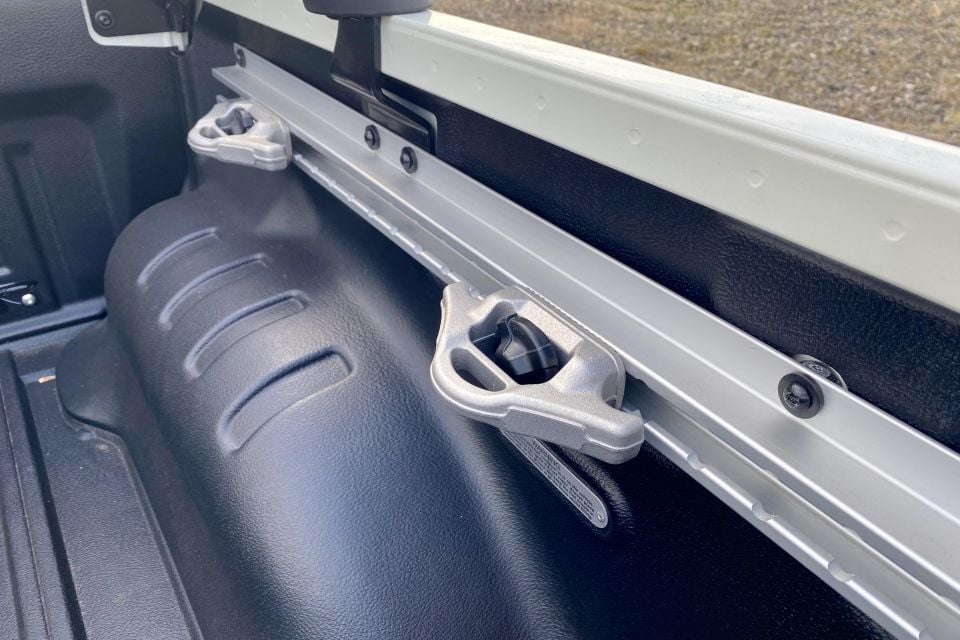
The Nissan counters with unique features such as an auto-dimming rear-view mirror, moving tub tie-downs on rails, a 360-degree camera (reversing camera in the Isuzu), a steel sports bar, a sliding rear window, rear privacy glass, and an assisted tailgate.
You can also option a sunroof in the Nissan alongside the leather seat package mentioned earlier. The combined cost is $2500.
Both brands offer a full catalogue of body accessories to add on (like the snorkel and wheel arch flares on our test Nissan). If I detailed those lists here then the review would take days to wade through, but there’s the info on each brand’s website.

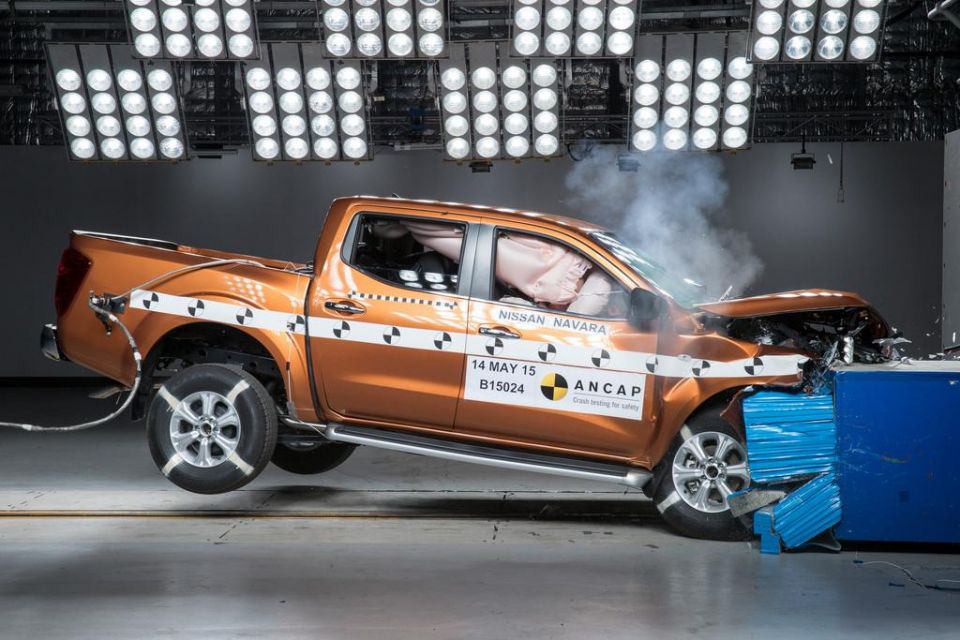

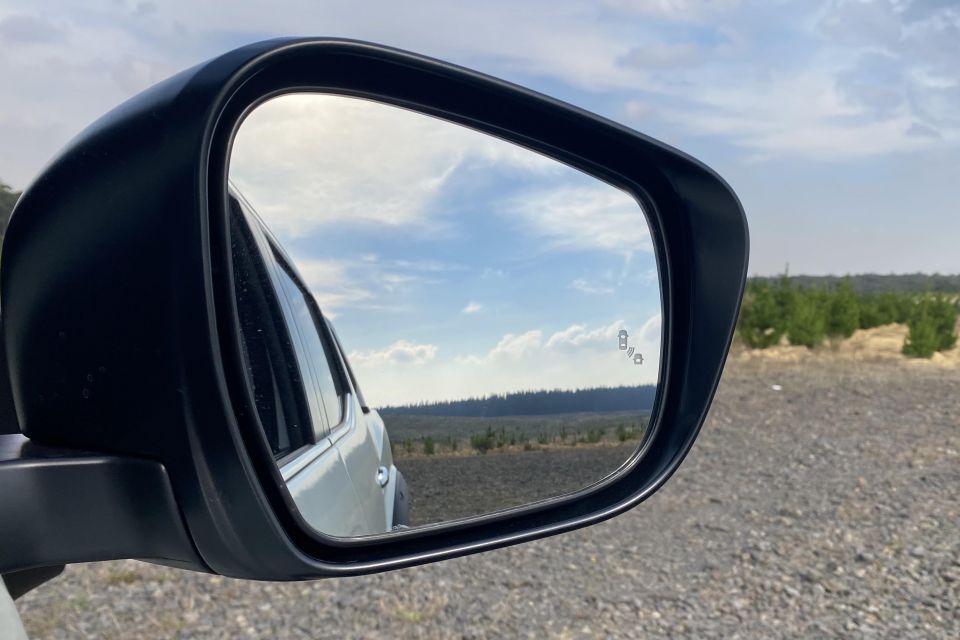
Common to both are seven airbags (two up front, two in each front seat bolster, full-length side curtains, driver’s knee), autonomous emergency braking with forward collision alert, lane-departure warning, blind-spot monitoring, rear cross-traffic alert, and rear parking sensors.
To this list the Isuzu adds a front-centre airbag, active steering assist for lane-keeping, adaptive cruise control, ultrasonic misacceleration mitigation, and front parking sensors.
Crash tester ANCAP awarded the D-Max a five-star rating against the latest 2020 protocols. The Nissan is also a five-star ANCAP vehicle but with a 2015 date stamp.
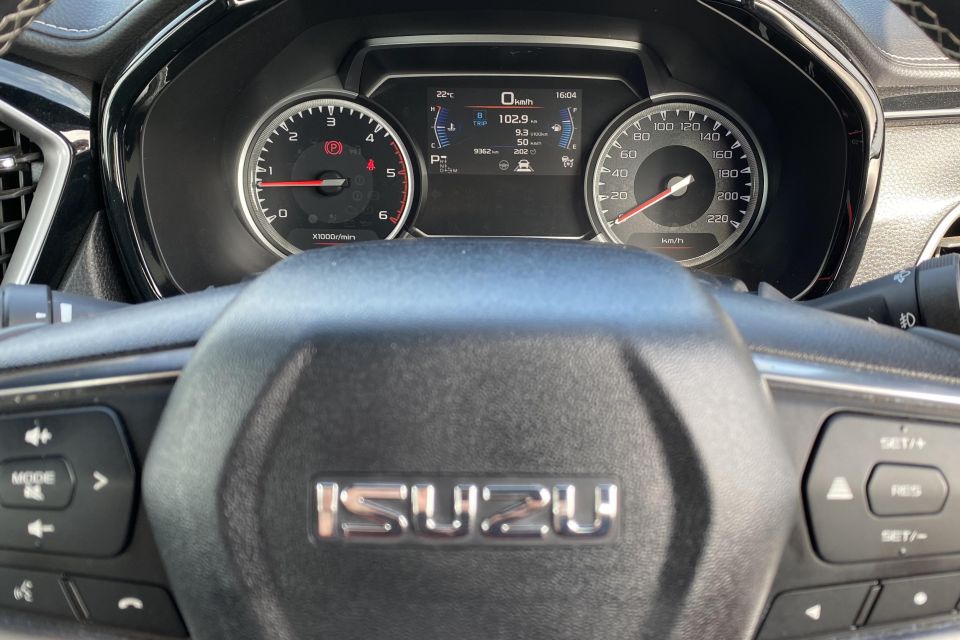
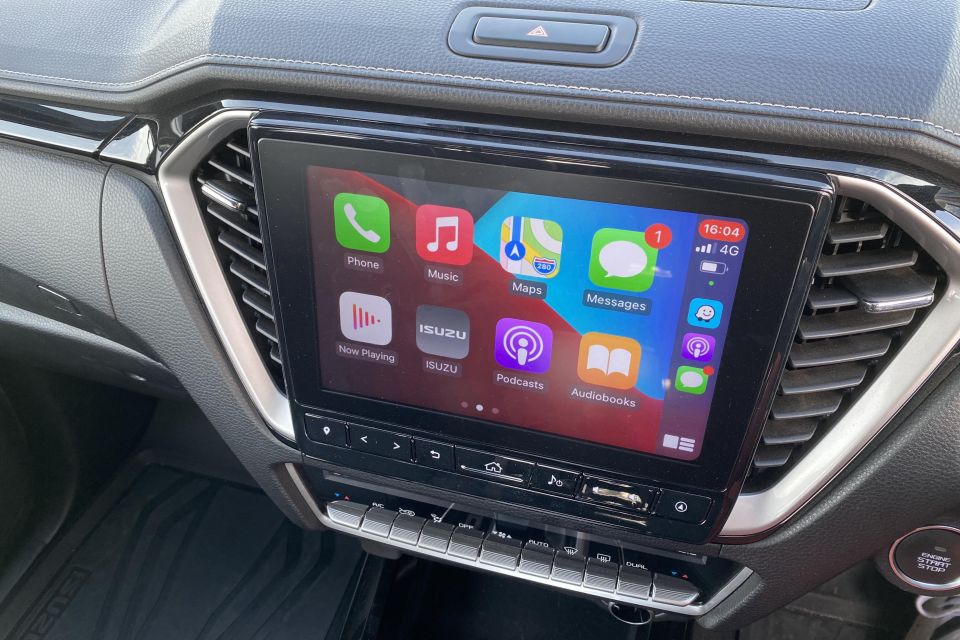
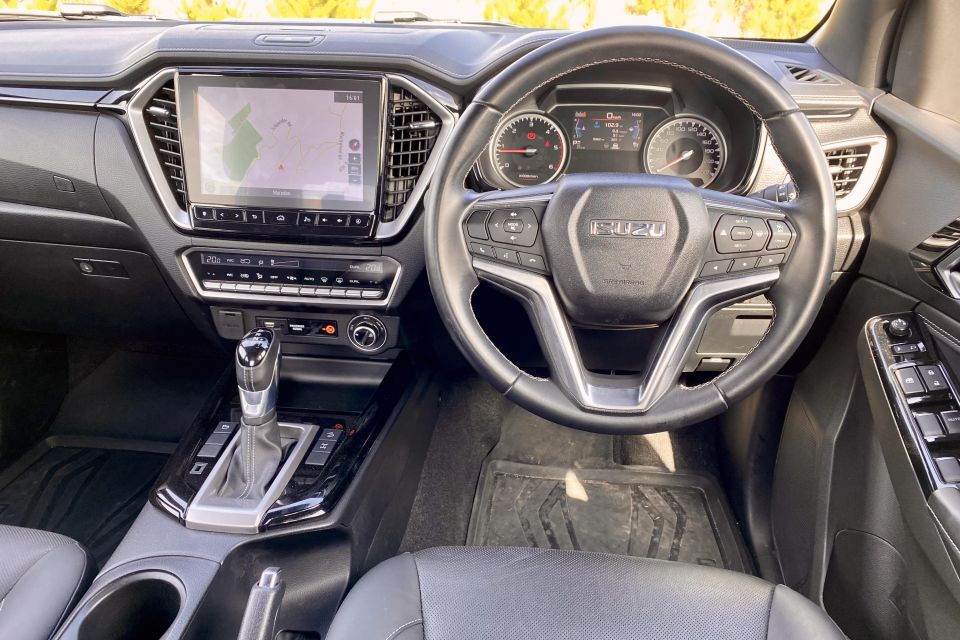
Isuzu up front:
The highlight of the Isuzu’s cabin are its front seats, which are super supportive and remind one very much of an old Commodore’s – by that, I mean they’re made to handle the burliest of blokes.
The steering wheel now has telescopic adjustment unlike the old D-Max, and the trip computer contains a digital speedo.
The centre touchscreen is bigger than most competitors’, and while the home screen isn’t overly intuitive, the maps are great and the availability of wireless Apple CarPlay very handy if you’re allergic to cabin clutter.
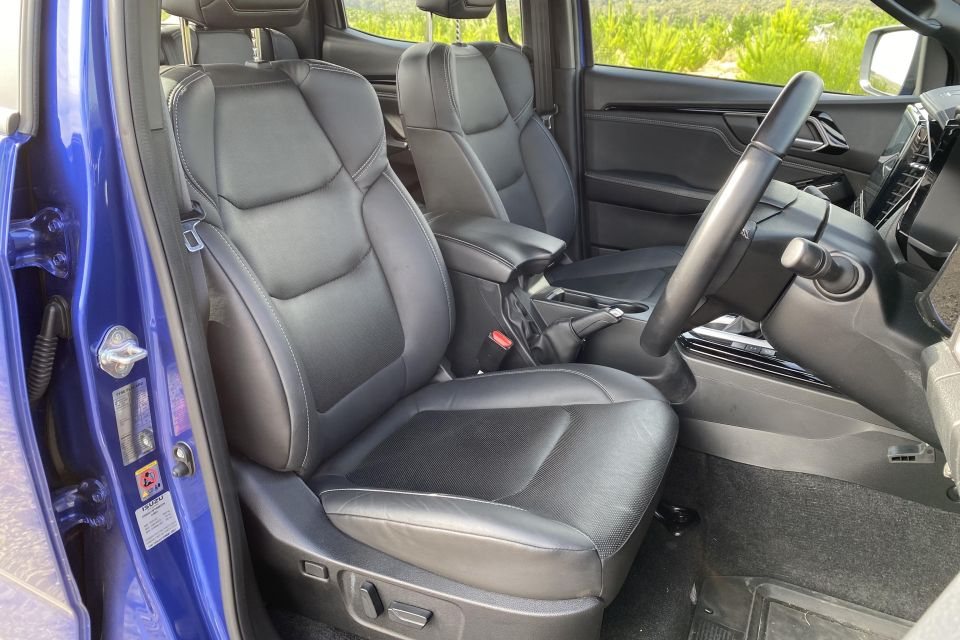

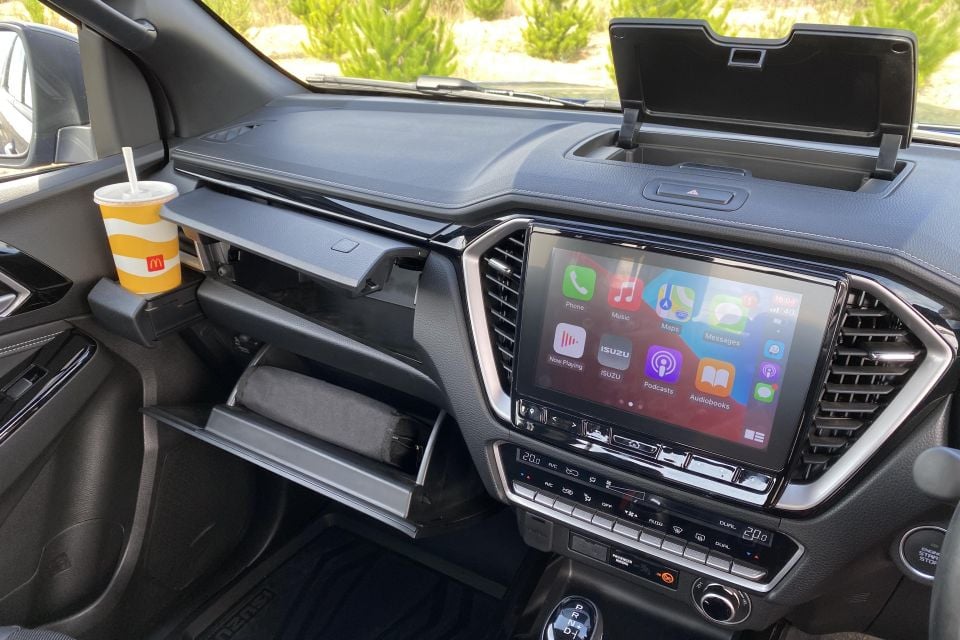
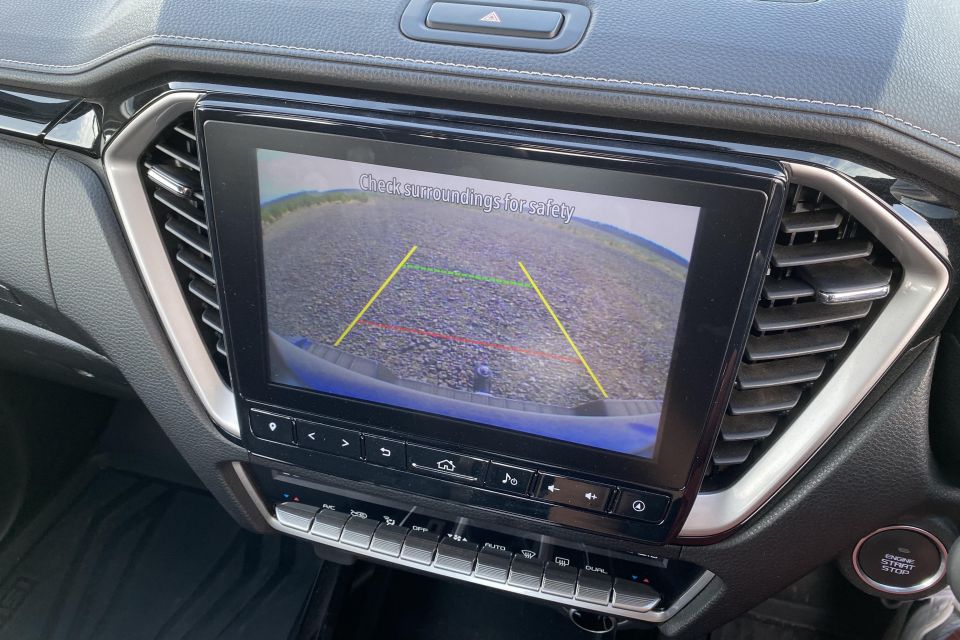
That sound system is also excellent, thanks in large part to the roof-mounted speakers.
Ventilation functions are controlled by a series of rocker switches that to my eyes looks far slicker than Nissan’s messier ventilation control bank. But hey, the functions are the same.
There are plenty of nice padded touch points on the doors, the dash, and along the centre tunnel, which adds a nice feel.
There’s also more cabin storage than the Nissan offers, including a cubby atop the dash, two slide-out cupholders, and double closing gloveboxes.
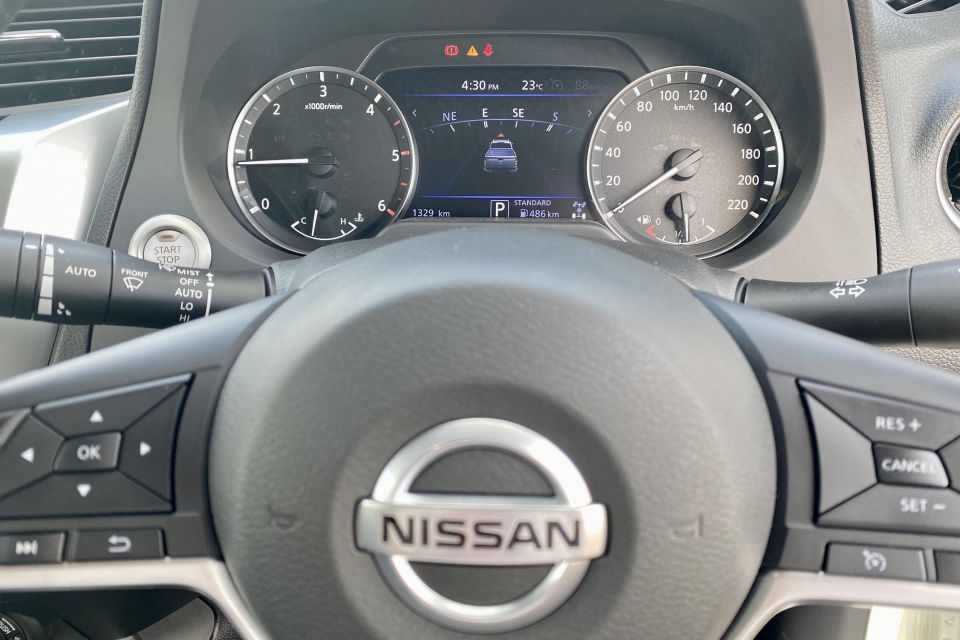
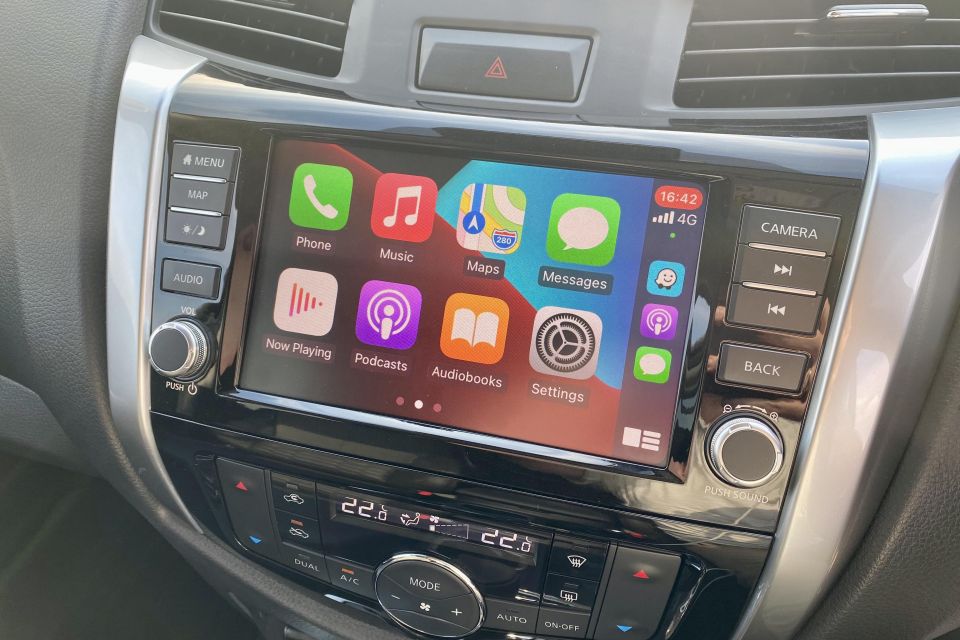
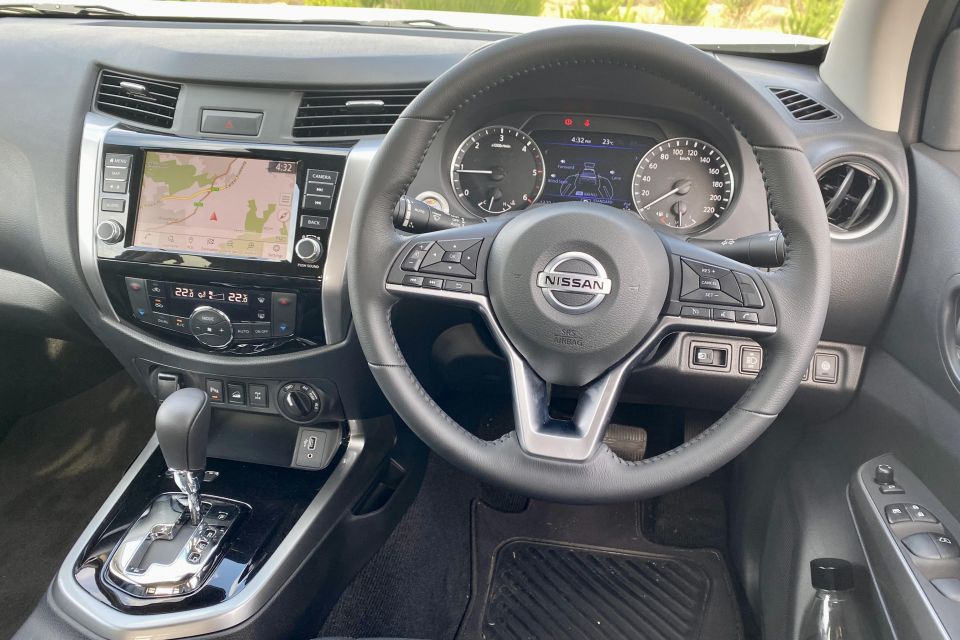
Nissan up front:
Even with the leather pack fitted, the Nissan’s seats aren’t as supportive as the Isuzu’s, and you sit perched a little higher. Moreover, the absence of steering-wheel reach adjustment means it’s harder to nail your driving position.
However, the new steering wheel design is far better than the pre-update Navara’s, ditto the crisp trip computer that has nicer graphics and slicker menus than the Isuzu’s.
The Nissan’s one-inch smaller screen (8.0-inch versus 9.0-inch) is flanked by buttons and – unlike the D-Max – offers volume and map-zoom knobs. It also has a side-view camera, though the resolution is a bit grainy.
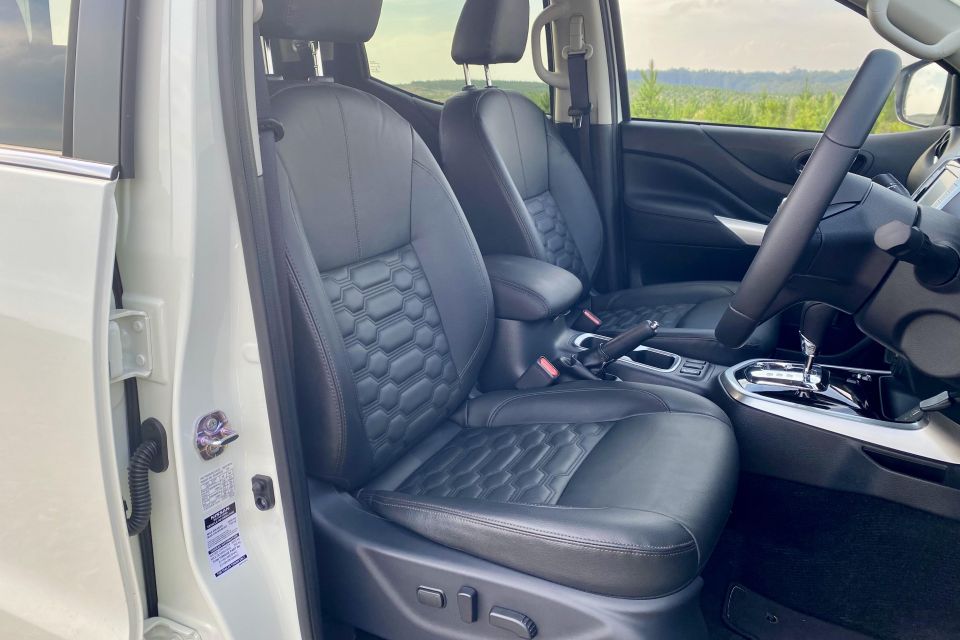
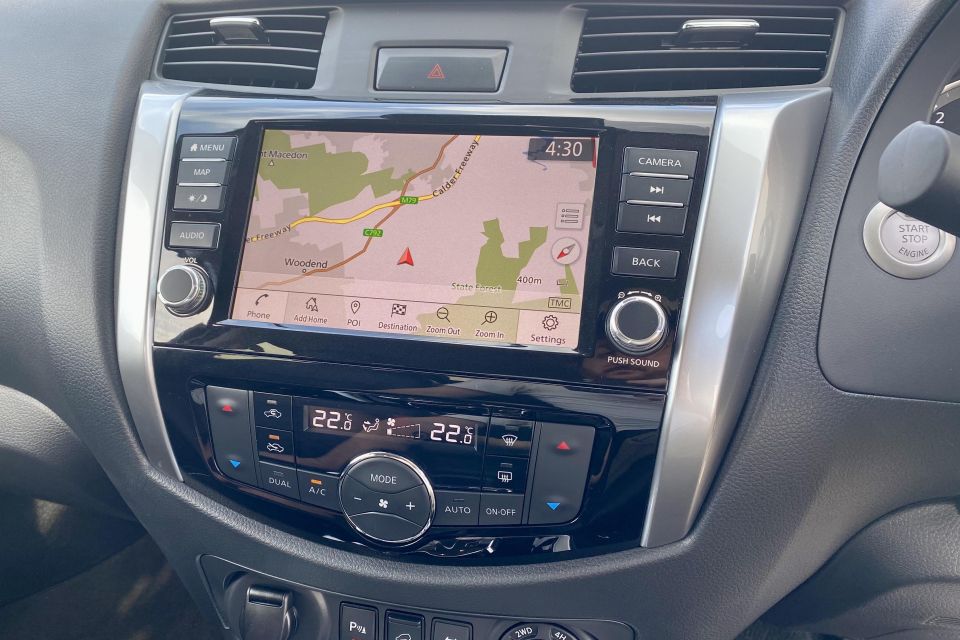
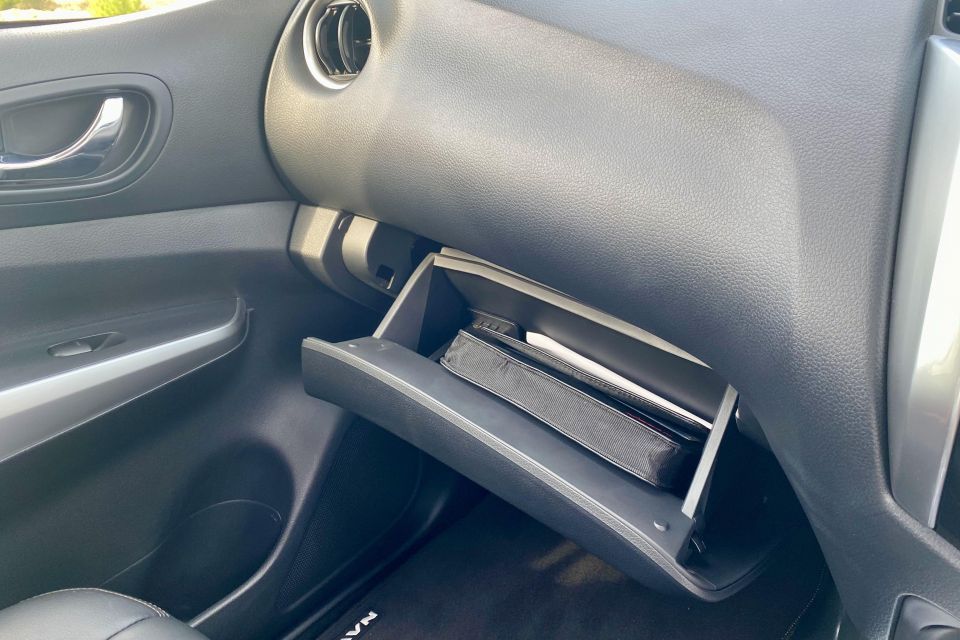
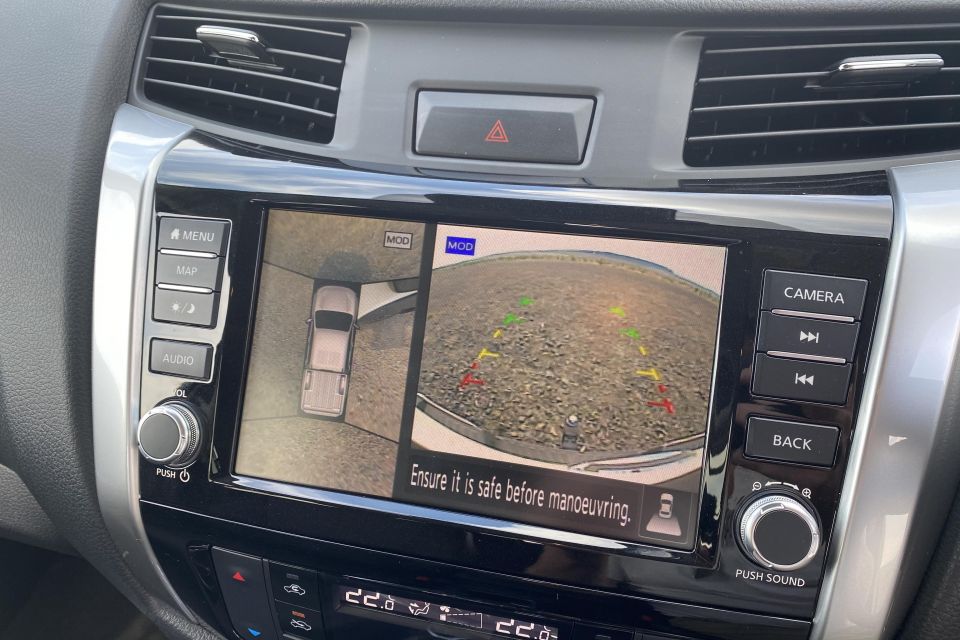
Cabin storage is more limited than in the D-Max as mentioned above, and I’m dismayed Nissan removed the slide-out high-mounted cupholders from the last Navara update.
The tunnel design in the Nissan also means there’s a touch less space for your knees up front, at least based on my experience.
While the Nissan’s interior doesn’t look quite as swish as the newer Isuzu’s does, and has more hard plastics, its build quality feels superior to the Isuzu, which has a few squeaky trims that stand out next to the rock-solid Navara.
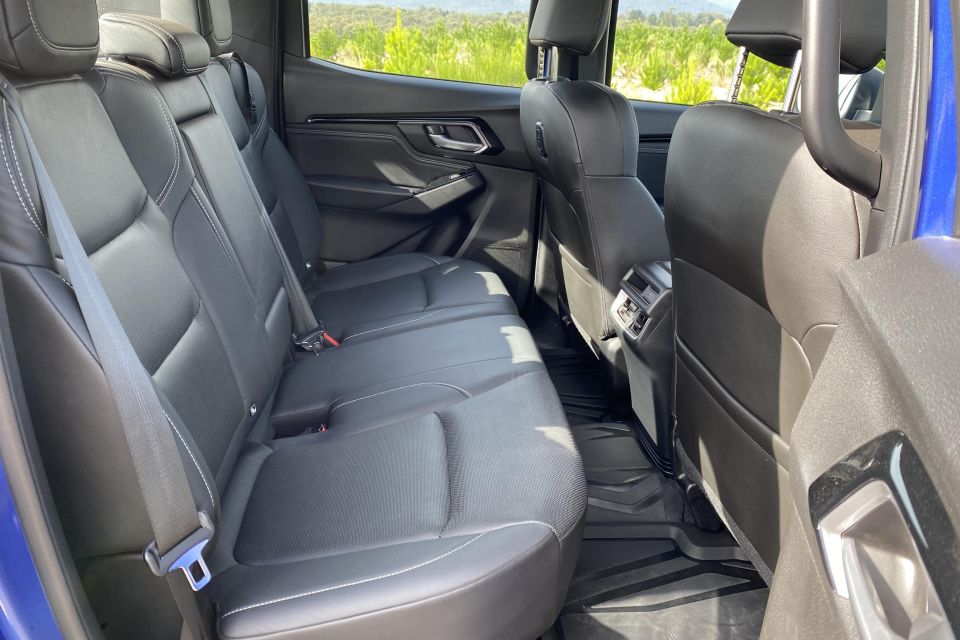
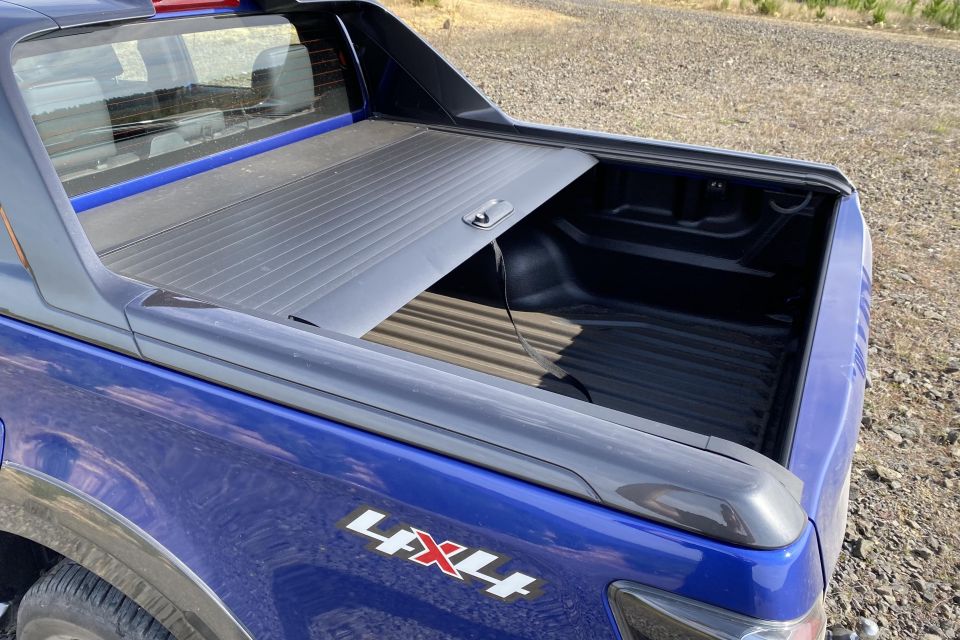
Back seats and tubs:
In terms of the back seats, both offer grab handles on the B-pillars, rear vents, a rear USB point, cupholders, and child-seat attachments. Only the Nissan gives you a sliding back window, which is a small-but-worthy feature.
While both are capable of performing family duties, the D-Max is packaged better. That’s because despite its shorter wheelbase, it offers more rear legroom.
I’m 194cm and my knees just fit behind my own seating position in the Nissan, whereas they fit with an inch to spare in the Isuzu.
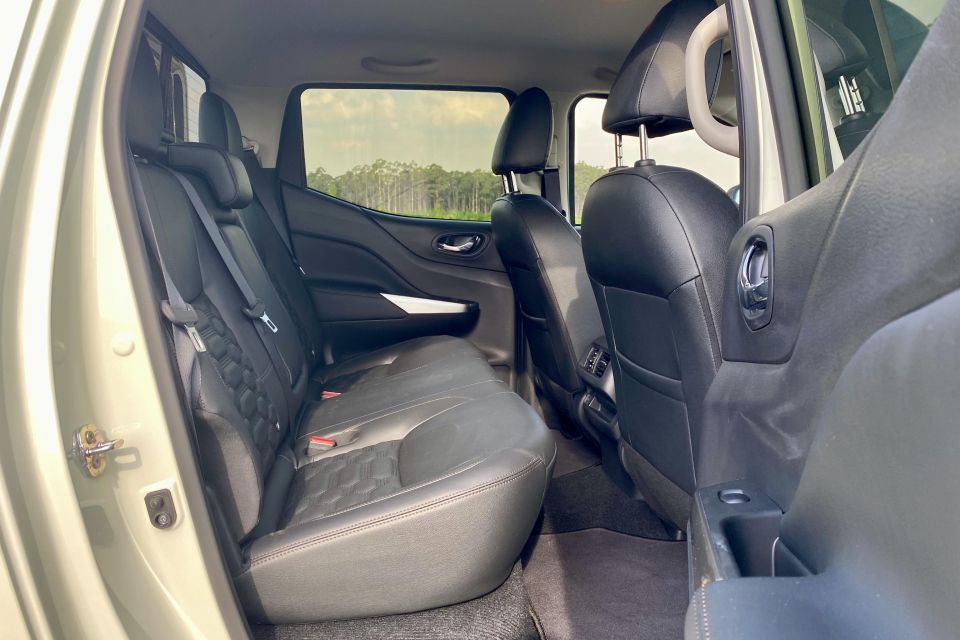

The tubs are more or less the same size as the table below shows, but the Nissan’s clever moving tie-down points on rails and its assisted easy-lift tailgate are great, unique features here.
The Isuzu’s roller-cover is secure, but be aware that it also reduces cargo capacity.
Note the Nissan’s superior 1024kg payload, which is 54kg greater than the D-Max’s.
| Isuzu D-Max X-Terrain | Nissan Navara ST-X | |
|---|---|---|
| Length | 5280mm | 5311mm |
| Width | 1880mm | 1850mm |
| Height | 1810mm | 1830mm |
| Wheelbase | 3125mm | 3150mm |
| Max tub length | 1495mm | 1469mm |
| Max tub width | 1530mm | 1560mm |
| Tub between wheels | 1122mm | 1134mm |
| Tub depth | 490mm | 519mm |
| Payload | 970kg | 1024kg |
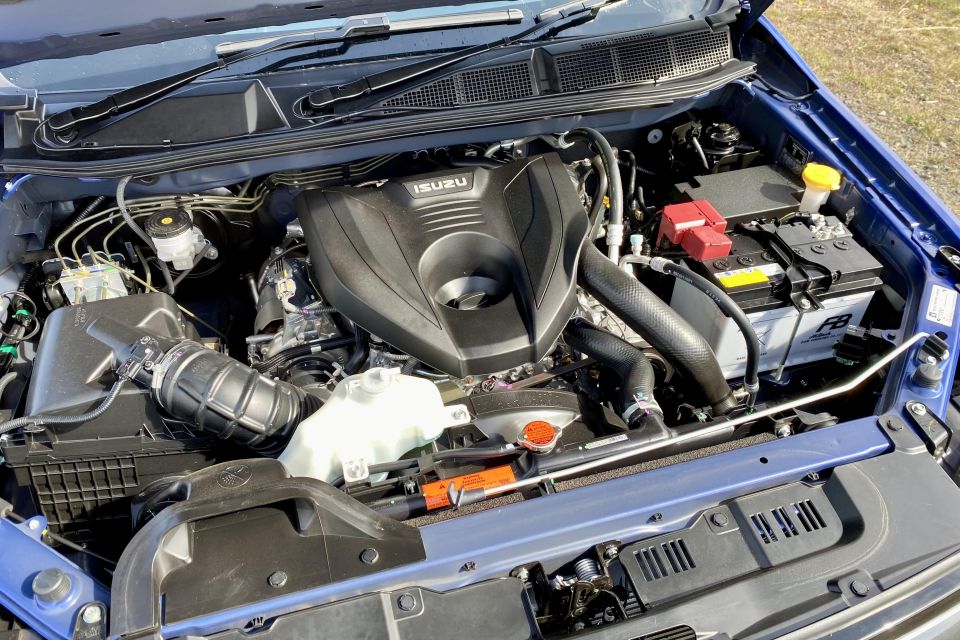

This pair have identical outputs, though the Isuzu has an extra 700cc of engine capacity.
The D-Max’s 3.0-litre single-turbo-diesel four makes 140kW of power at 3600rpm and 450Nm of peak torque at 1600rpm. By contrast the Nissan’s 2.3-litre twin-turbo-diesel four makes 140kW at 3750rpm and 450Nm at 1500rpm.
The Isuzu uses a six-speed automatic whereas the Nissan’s auto has seven speeds.
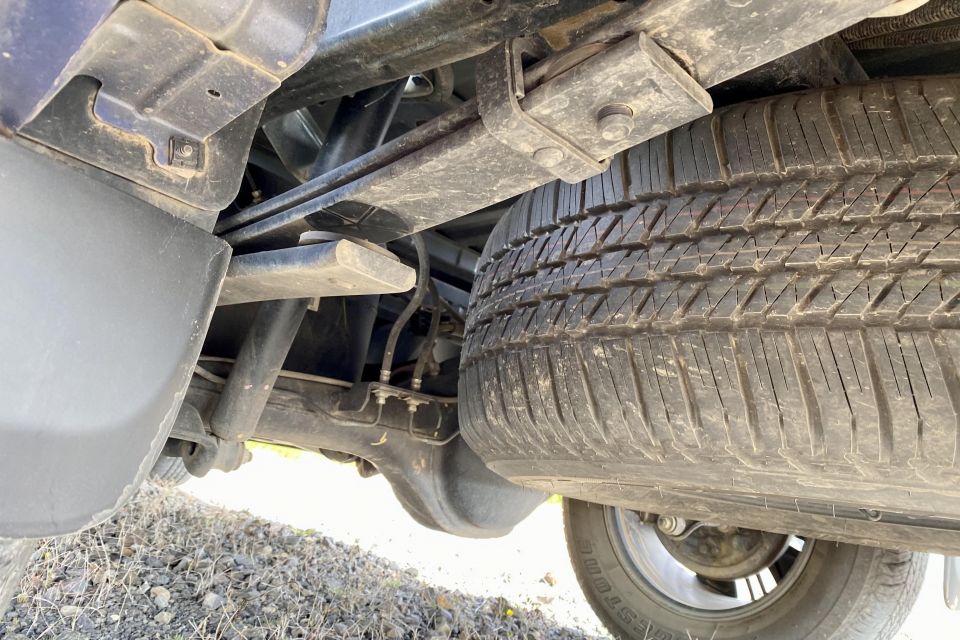
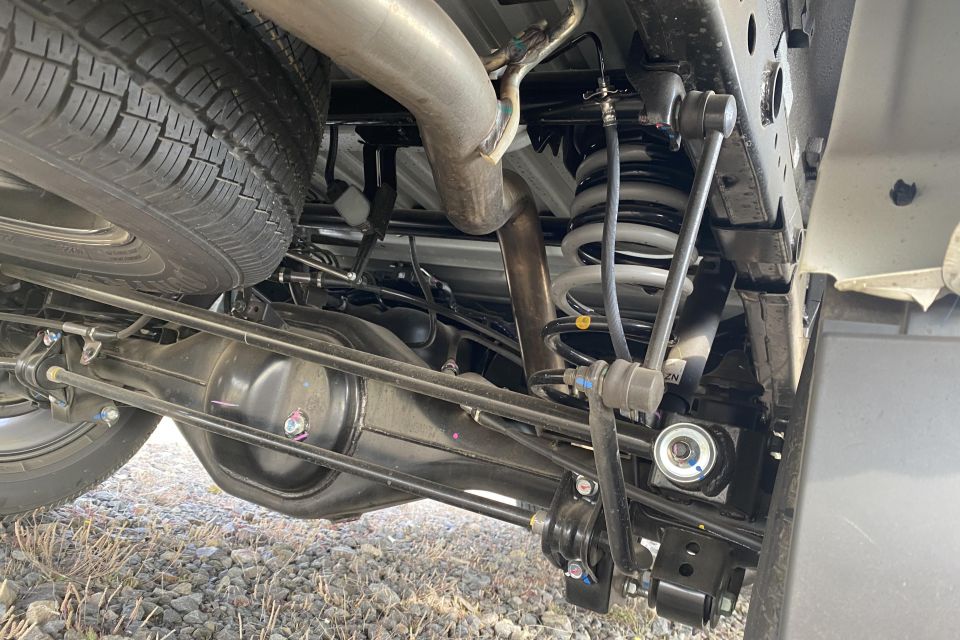
Both come with part-time 4×4 that defaults to rear-wheel drive and can be activated to high-range 4WD on the fly, and then into low-range once you bring each to a halt and enter neutral gear.
Isuzu claims fuel use of 8.0L/100km compared to 7.9L/100km for the Nissan, with the respective fuel-tank storage capacities 76L and 80L.
Both are rated to tow up to 3.5 tonnes with trailer-braking.
| Isuzu D-Max X-Terrain | Nissan Navara ST-X | |
|---|---|---|
| Fuel type | Diesel | Diesel |
| Displacement | 3.0-litre | 2.3-litre |
| Cylinders | Four | Four |
| Power | 140kW @ 3600rpm | 140kW @ 3750rpm |
| Torque | 450Nm @ 1600rpm | 450Nm @ 1500rpm |
| Fuel economy | 8.0L/100km | 7.9L/100km |
| Fuel tank | 76L | 80L |
| Towing capacity | 3.5 tonnes | 3.5 tonnes |
| Transmission | Six-speed auto | Seven-speed auto |
| Drive type | Part-time 4×4 | Part-time 4×4 |
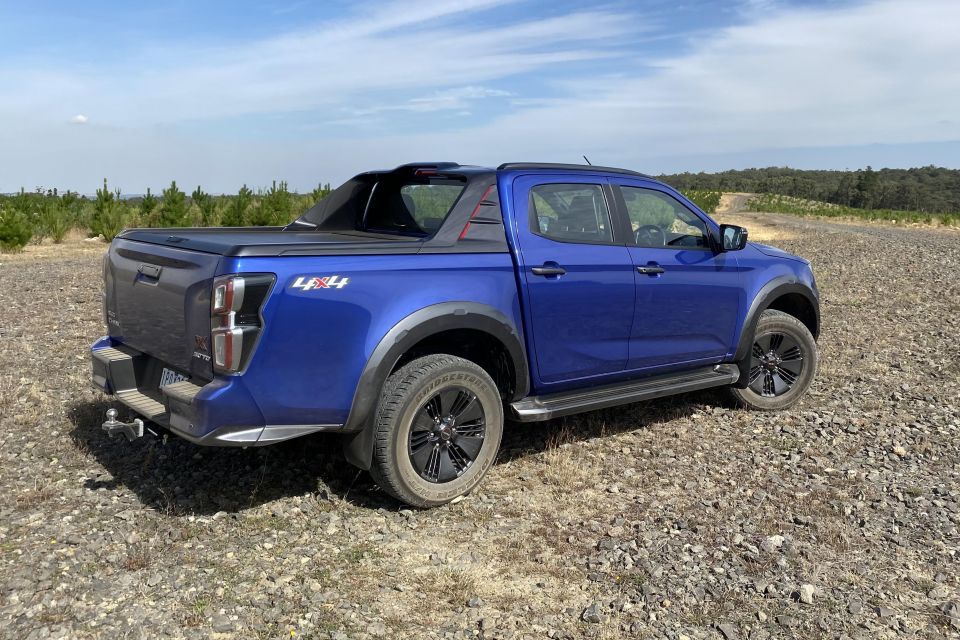
Where expert car reviews meet expert car buying – CarExpert gives you trusted advice, personalised service and real savings on your next new car.
Drivetrains:
The Isuzu’s engine is a ripper that belies its middling outputs to offer strong response from right down low. My best 0-100km/h time of 9.47 seconds was 0.33 sec faster than the Navara’s.
It does a great job of delivering torque whenever you need it. The gearbox is clever enough to stay in the same gear and lean on the torque band instead of hunting through its ratios.
My fuel use was 8.6 litres per 100km, meaning Isuzu’s claim looks pretty on the money.

The latest Navara update didn’t bring any engine changes. The 2.3 uses low-pressure and high-pressure turbos.
It doesn’t feel quite as urgent or strong through the mid-range as the D-Max. But it has an extra gear ratio to play with, meaning they’re spaced closer together, and the tall seventh helps cut fuel use and boost refinement at highway pace.
I was certainly impressed by the Nissan’s refinement levels. From inside, with the throttle pinned, the engine noise intruding past the acoustic glass and firewall deadening was 4dB lower than I recorded in the Isuzu.
My fuel use was actually 8.5 litres per 100km, even better than the D-Max. Again, credit for the honest ADR claim.
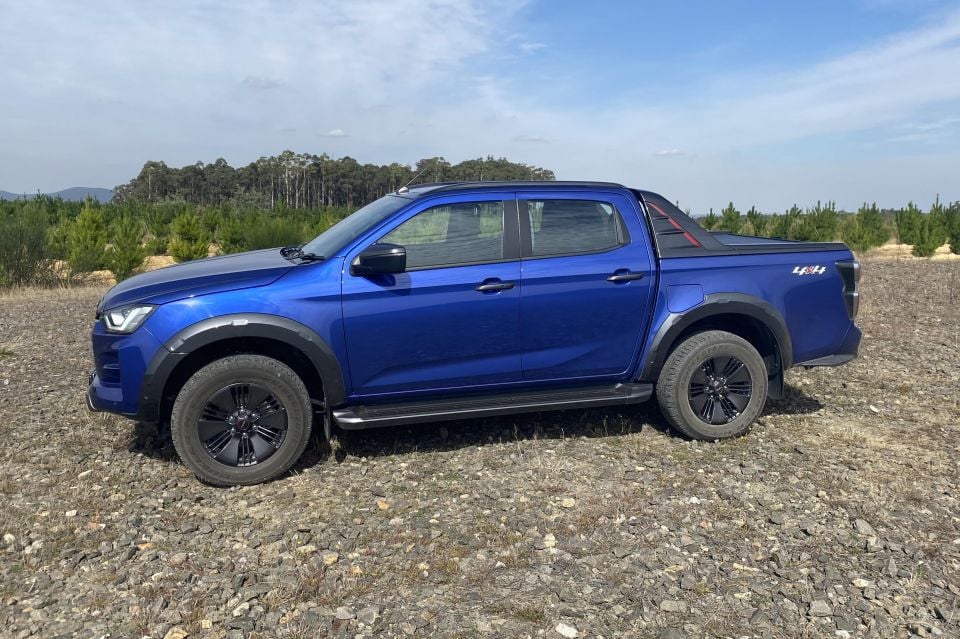
Dynamics:
The Isuzu’s motor-driven steering is far more assisted and therefore lighter than the Nissan’s, which is a hydraulic-assisted setup. This means the D-Max’s wheel offers less road feel but is much easier on the arms.
The refinement levels in the Navara are superior, with less wind noise over the side mirrors evident, and a max decibel reading on coarse chip road of 69dB versus 71dB in the D-Max.
Suspension-wise, the D-Max uses more conventional leaf springs at the rear compared to the Navara’s five linkages and two-stage coils.
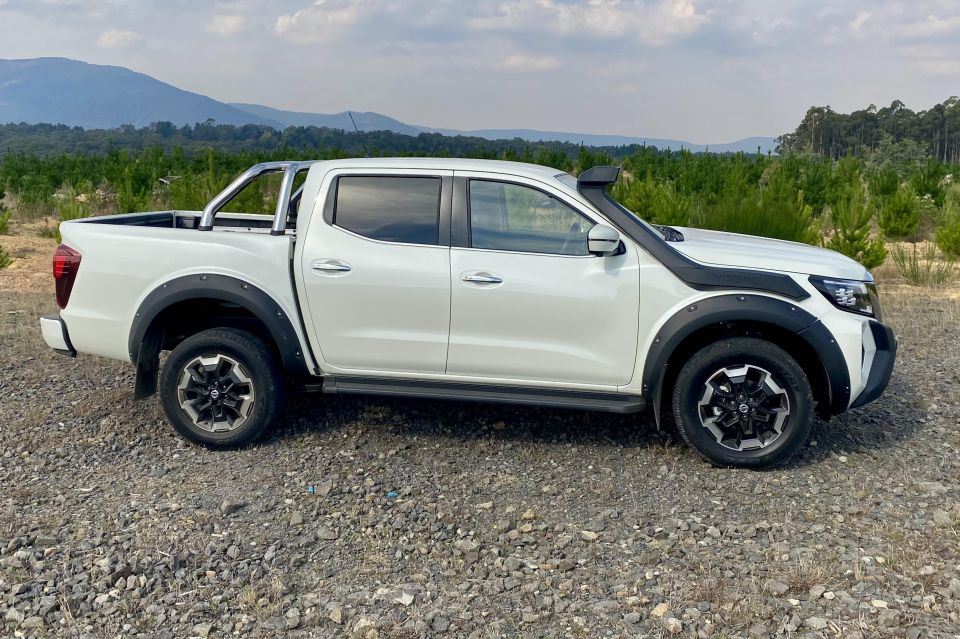
Perhaps surprisingly, the Isuzu feels a little softer and more pliant, whereas the Navara rides a little more firmly but also settles after bumps faster.
Off the beaten path, both come with lockable rear diffs, but the Isuzu has an extra 16mm of clearance.
I’ve driven both of these off-road and walked up craggy hills, loggy slopes, and over offset moguls. Just beware the side steps and be sure to fit some proper all-terrain tyres if you’re a keen weekend warrior.
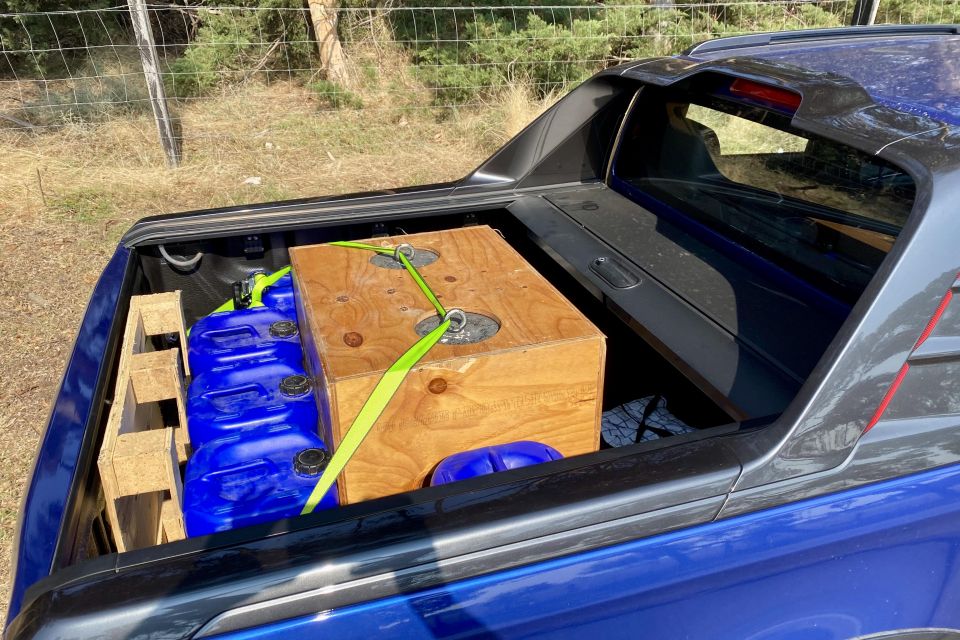
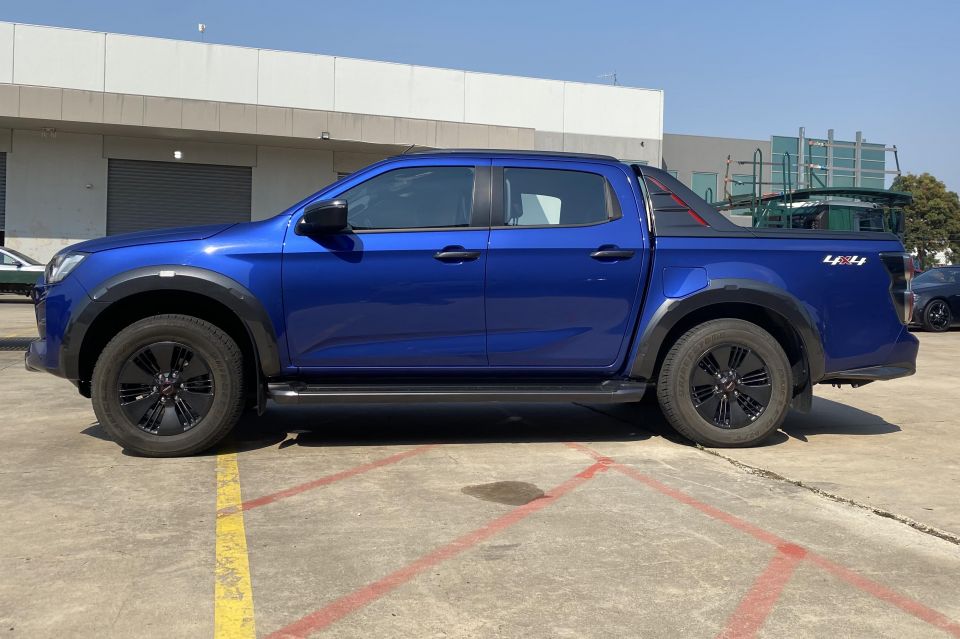
I also loaded up each ute on test with 650kg – I couldn’t fit both cinderblocks in the Isuzu’s tub because of the bulky roller tonneau, so had to put a few water weights in the back seats – and found the coil-sprung Nissan actually sat more level.
Neither ute felt fazed by the weight over speed humps, both felt a little more settled after hits, and each managed a 0-100km/h laden dash 2.0 seconds slower than when unladen.
To conclude, the Nissan’s steering is weightier, the engine quieter, and the suspension less plush but quicker to settle the body. But, the Isuzu feels more wieldy, punchier, and pliant.
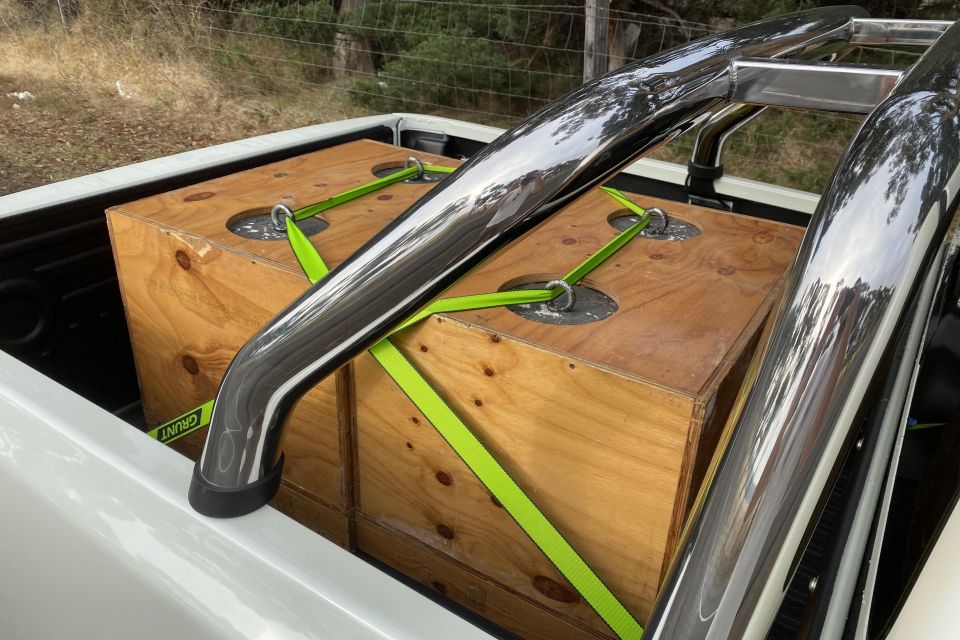
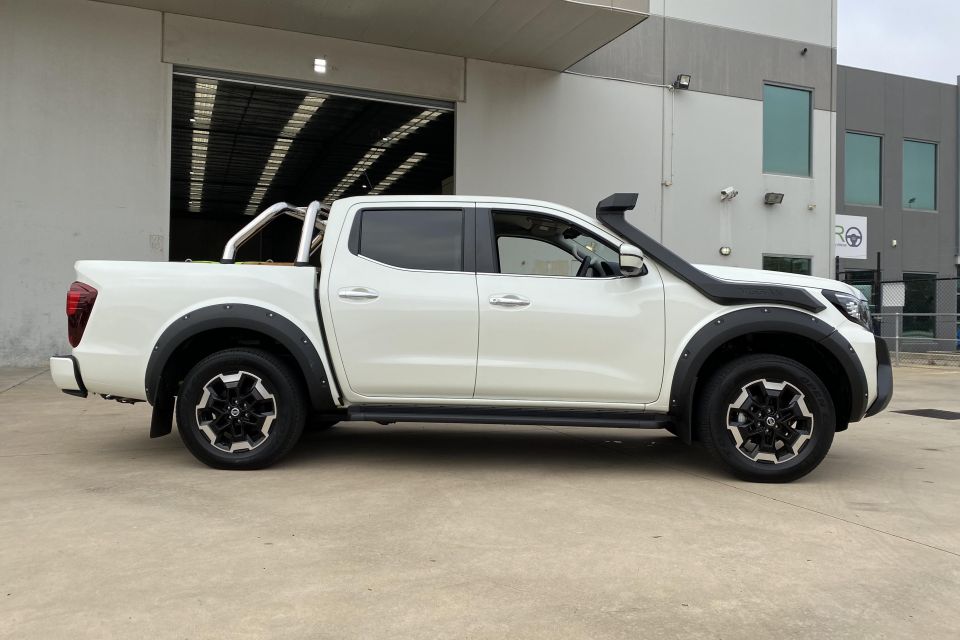
In terms of active safety, only the Isuzu’s lane keeping and centring aids actually make steering adjustments, and it works pretty well. It’s also the only car here with adaptive cruise control.
Not only that, but the Nissan’s passive cruise control lets the Navara pick up speed down hills.
One thing I should note: the D-Max’s front stereo camera that controls the active safety systems needs a few minutes to recalibrate if you’re carrying enough payload to change the vehicle’s stance, which means you’ll be spending some time without these systems.
| Isuzu D-Max X-Terrain | Nissan Navara ST-X | |
|---|---|---|
| Kerb weight | 2130kg | 2142kg |
| Gross vehicle mass | 3100kg | 3150kg |
| Gross combined mass | 5950kg | 5910kg |
| Front brakes | Ventilated discs | Ventilated discs |
| Rear brakes | Drums | Drums |
| Front suspension | Double wishbone | Double wishbone |
| Rear suspension | Leaf springs | Coil springs |
| Power steering | Electric assisted | Hydraulic assisted |
| Ground clearance | 240mm | 224mm |
| Approach angle | 30.5 degrees | 32.7 degrees |
| Departure angle | 24.2 degrees | 20.3 degrees |
| Breakover angle | 23.8 degrees | 23.2 degrees |

Isuzu offers a six-year, 150,000km warranty, whereas Nissan provides a five-year and unlimited-kilometre warranty.
The Isuzu’s service intervals are 12 months or 15,000km and the first seven visits are capped at $389, $409, $609, $509, $299, $749, and $409.
The Nissan’s intervals are 12 months or a lengthy 20,000km and the first six visits are capped at $502, $539, $703, $560, $543, and $775.

This contest is pretty close.
The Navara is much improved, with newfound active safety credentials, tougher looks, more refinement, and some welcome interior enhancements. It also edges the Isuzu for payload, and its suspension seems more load-friendly and quicker-settling.
Yet the D-Max’s punchier engine, better driving position, more modern interior technology, extra active safety features, and comparatively wieldy steering make it narrowly my pick for those after a premium lifestyle-friendly ute.
This was a ding-dong battle though, which shows that Nissan got this latest Navara update pretty right.
MORE: Isuzu D-Max showroom page MORE: Nissan Navara showroom page
Share your thoughts with us in the comments below!
Share your thoughts and write a review of a car you own and get featured on CarExpert.


Matt Campbell
1 Hour Ago
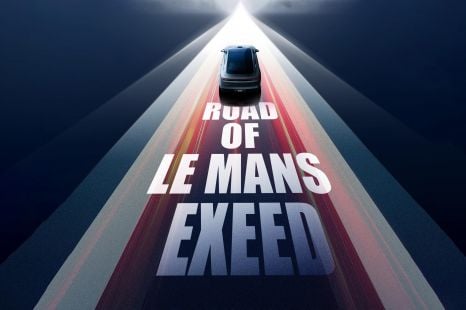

Andrew Maclean
8 Hours Ago


Max Davies
8 Hours Ago


Max Davies
8 Hours Ago
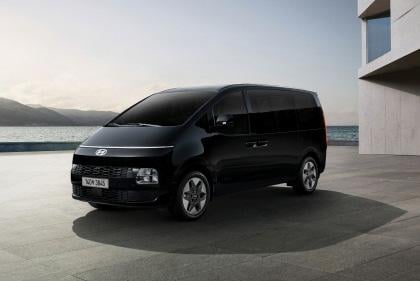

Damion Smy
10 Hours Ago
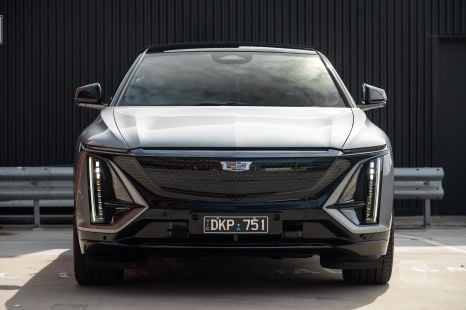

William Stopford
14 Hours Ago